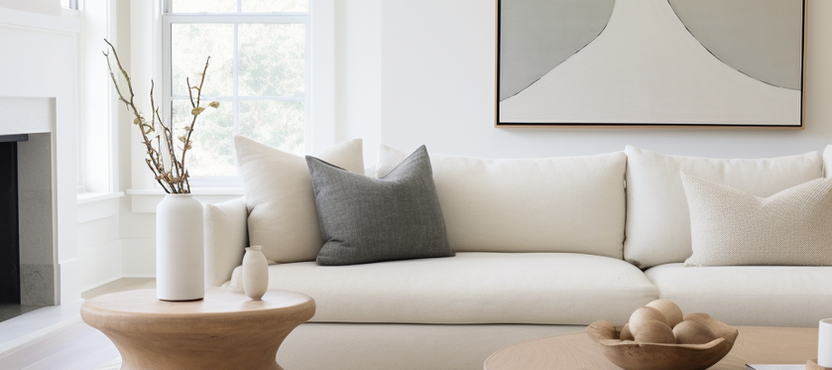Dorian Gray vs Repose Gray: The Shade-Choosing Method That Never Fails Us
- Beril Yilmaz

- 1 hour ago
- 8 min read
Choosing between Dorian Gray vs Repose Gray feels deceptively simple… until you see how dramatically they shift once they’re on the wall. This guide takes the guesswork out in minutes.
There’s something uniquely stressful about standing in front of a fan deck trying to decide between two colours that look almost identical on paper. Dorian Gray vs Repose Gray is one of those classic homeowner dilemmas — the kind where the undertones, lighting, and finishes all jump in to complicate what you hoped would be a straightforward decision. If you’ve ever painted a patch on the wall only to stare at it with rising confusion, you’re not alone.
We’ve seen these two shades behave beautifully in some homes and unexpectedly challenging in others, and the reason is always the same: understanding how each colour reacts in real spaces. Undertones, daylight direction, flooring, trims, even your soft furnishings — everything either supports or fights against a grey. When clients ask us which one is “better,” the truth is that neither wins until we look at the environment it’s going into.
That’s why we’ve created this breakdown — not just to compare Dorian Gray vs Repose Gray, but to give you the exact method we use in client projects to choose the right one with confidence. By the end of this blog, you’ll be able to look at your room and know instantly which shade is working with you, not against you.
At A Glance
What makes Dorian Gray and Repose Gray different
How undertones shift in natural and artificial lighting
Which shade suits north-facing vs south-facing rooms
How each colour interacts with flooring and furniture
How to sample these greys correctly
When Dorian Gray wins
When Repose Gray wins
1. Dorian Gray vs Repose Gray: Understanding Undertones

Dorian Gray and Repose Gray may sit close together on the Sherwin-Williams chart, but their undertones behave very differently once they’re on the wall. Dorian Gray leans stronger into its depth, giving you a more defined greyness. In contrast, Repose Gray contains a subtle hint of taupe that becomes visible depending on the time of day and the amount of light entering the room.
When clients view these side by side, the temptation is to see them as interchangeable. They’re not. Undertones decide everything from how crisp your white trim appears to whether your flooring suddenly looks mismatched. The trick is to observe how each shade plays against your permanent elements — flooring, cabinets, and architectural details. These fixed points reveal undertones faster than any sample card.
Designer Tip: If you’re painting near beige or cream furnishings, Repose Gray typically resolves more harmoniously, while Dorian Gray often suits cooler, modern materials.
YOU MAY LIKE
2. Dorian Gray vs Repose Gray: Natural Light and Orientation

Light direction is one of the biggest reasons two rooms painted the same colour can feel completely different. In north-facing rooms, both colours shift slightly, but Dorian Gray becomes noticeably stronger. Its depth interacts with limited daylight, creating a more pronounced presence. Repose Gray softens in northern light and can sometimes appear flatter depending on the room’s finishes.
South-facing spaces offer the most flexibility for both shades. Here, Dorian Gray maintains its clarity without feeling overpowering, and Repose Gray gains a balanced appearance that works well in interior rooms without many windows.
Designer Tip: For rooms that have daylight only in the morning or evening, sample patches in both time frames. These colours shift dramatically within 24 hours.
3. Dorian Gray vs Repose Gray: Flooring and Fixed Materials

The quickest way to narrow your choice between Dorian Gray vs Repose Gray is to focus on the flooring. Timber with yellow or orange undertones can bring out unexpected warmth in Repose Gray, while Dorian Gray tends to stay more neutral alongside these tones. In contrast, cool-toned woods or greige floors harmonise easily with both colours, but each one creates a different design story.
If your flooring leans dark, Dorian Gray provides a balanced contrast that looks considered rather than heavy. For pale timber floors, Repose Gray brings a level of ease that feels consistent across the space without fighting the natural material.
Designer Tip: Always place samples vertically next to your skirting boards, not flat on the floor — that’s how you see the true interaction of colour and material.
4. Dorian Gray vs Repose Gray: How They Behave With White Trim

This is where many homeowners get caught out. Not all whites behave well with greys, and both of these colours react noticeably depending on the trim shade. Clean, crisp whites bring out the structure of Dorian Gray beautifully, while warmer whites tend to make Repose Gray appear more layered in tone. If you use an off-white trim, the subtle taupe undertone in Repose Gray becomes more noticeable.
Avoid pairing these greys with creams that lean yellow. They cause shifts that look unintentional rather than harmonious. If you already have warm trim you can’t change, Repose Gray tends to adapt better, especially in rooms with consistent lighting.
Designer Tip: For a balanced trim pairing, Sherwin-Williams Pure White is one of the safest options for both colours.
5. Dorian Gray vs Repose Gray: Comparing Real Room Scenarios

Seeing these colours in controlled studio light is one thing — seeing them in real homes is another. In open-plan spaces, Dorian Gray often creates a sense of visual structure that helps define zones. Repose Gray flows more softly across multiple areas, making it well-suited for large layouts that rely on cohesion rather than strong contrasts.
In bedrooms or smaller rooms, the decision depends entirely on the atmosphere you want to create. Dorian Gray leans stronger and more decisive, whereas Repose Gray offers a gentle neutrality without losing identity.
Designer Tip: If you have low ceilings, Repose Gray helps maintain balance without visually lowering the height.
6. Dorian Gray vs Repose Gray: Knowing When Each Shade Wins

This is where the bullet section is helpful, so here is one of your three allowed extra bullet lists.
Choose Dorian Gray if your space needs more visual definition
Choose Dorian Gray for rooms with strong natural light
Choose Dorian Gray to complement modern finishes like concrete, steel or cool-toned woods
Choose Repose Gray for open-plan layouts needing a consistent flow
Choose Repose Gray for balancing warm flooring or beige-toned elements
Choose Repose Gray in rooms where you want a calmer grey that doesn’t overpower the space
Designer Tip: When in doubt, sample both in the same spot — the winner is always obvious when side by side.
Ready To Choose The Right Colour For Your Home?
If analysing undertones feels overwhelming, you’re not alone — this is where collaboration becomes powerful. We guide clients through these decisions every day. If you’d like personalised advice, we’d love to help. You can book a free design consultation today to discuss your project.
7. Dorian Gray vs Repose Gray: Paint Samples Done the Right Way

This might be the most overlooked step in the entire process. How you test a paint colour matters just as much as the colour itself. Small swatches are misleading, and painting a tiny patch on a beige wall will set you up for confusion. The most effective method is to place a large sample board in several positions around the room over 48 hours.
Allow the paint to dry fully before judging the colour. Wet paint skews the finish and the undertones, and rushing the decision usually leads to repainting later. Remember that both Dorian Gray and Repose Gray shift significantly depending on reflection from floors, furniture and exterior light.
Designer Tip: Avoid testing samples near windows — this area receives the strongest and most inconsistent light.
8. Dorian Gray vs Repose Gray: How Each Shade Photographs

Clients often choose colours based on how they appear in inspiration photos, but those images are usually shot in perfect conditions with balanced editing. Dorian Gray photographs with stronger depth, while Repose Gray photographs lighter, sometimes appearing more neutral than it actually is in person.
If your home relies heavily on artificial lighting during darker months, the photographed appearance matters more. These visual cues help you consider how your finished space will look in both real life and on screen.
Designer Tip: Take photos of your samples at different times of day — it reveals undertone shifts you may not notice in person.
9. Dorian Gray vs Repose Gray: Combining With Furniture and Fabrics

The way these colours interact with your furnishings can make or break the final result. Fabric textures influence undertones more than people expect. Linen, cotton and blended neutrals all affect the appearance of greys when placed nearby.
For homes with modern furniture, Dorian Gray tends to feel more intentional because of its structured depth. For homes filled with natural textures and materials, Repose Gray usually blends more seamlessly, allowing the furniture to lead the design.
Designer Tip: Place cushions or fabric samples near your painted boards to see how they change the perception of colour.
10. Dorian Gray vs Repose Gray: The Foolproof Method We Use in Every Project

Identify your room’s lighting direction first
Compare each grey directly against flooring, trim and furniture
Test large sample boards, not small swatches
Observe the colour for a full 48 hours
Photograph the samples morning, afternoon and evening
Remove any sample that clashes with permanent fixtures
Choose the shade that supports the architecture, not just the décor
Designer Tip: The right grey always makes your existing elements look better — not the other way around.
Conclusion
Choosing between Dorian Gray vs Repose Gray isn’t about guessing — it’s about understanding how these greys behave in a real home. Once you compare undertones, observe the light, and test your samples correctly, the decision becomes surprisingly clear. These two shades serve very different purposes, and the more you look at them within your own space, the more confident you’ll feel choosing the one that supports your architecture, furnishings and long-term design.
Your home deserves a colour that makes everything around it work harder. With the method in this guide, you’ll find that decision becomes much more straightforward — and far more enjoyable.
FAQ: Dorian Gray Vs Repose Gray
1. Which colour is lighter in the dorian gray vs repose gray comparison?Repose Gray is lighter and tends to appear brighter in rooms with consistent natural light.
2. Is Dorian Gray or Repose Gray better for north-facing rooms?Repose Gray generally adapts better to the cooler tone of north-facing light, while Dorian Gray appears stronger and more defined.
3. Which shade works better with warm flooring in the dorian gray vs repose gray debate?Repose Gray typically pairs more easily with warm-toned floors, especially timbers with yellow or beige undertones.
4. How do I sample Dorian Gray and Repose Gray correctly?Use large sample boards, move them around the room over 48 hours, and avoid placing samples too close to windows.
Start Your Dream Home Transformation With Us
Choosing colours is only the beginning — creating a thoughtful, beautifully designed home is where the magic happens. If you’re ready to take the next step in making your space feel considered and complete, we’d love to guide you through it. Let’s bring your vision to life together. You can book a design consultation today and start your project with confidence.
Author Bio
Beril Yilmaz is an interior designer known for creating purposeful, visually balanced spaces rooted in understanding how colour, light and materials behave in real homes. Blending technical knowledge with an approachable design style, she helps homeowners make confident decisions that support both their architecture and lifestyle.




































